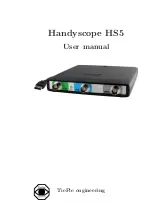
The Handyscope HS5 supports high speed continuous streaming
measurements. The maximum streaming rates are:
Handyscope HS5
Channels
Resolution
8 bit
12/14 bit
16 bit
Model 540
CH1
40 MS/s
20 MS/s
6.25 MS/s
CH1+CH2
20 MS/s
10 MS/s
Model 530
CH1
40 MS/s
20 MS/s
6.25 MS/s
CH1+CH2
20 MS/s
10 MS/s
Model 220
CH1
20 MS/s
10 MS/s
3.125 MS/s
CH1+CH2
10 MS/s
5 MS/s
Model 110
CH1
10 MS/s
5 MS/s
1.25 MS/s
CH1+CH2
4 MS/s
2 MS/s
Model 055
CH1
4 MS/s
2 MS/s
625 kS/s
CH1+CH2
2 MS/s
1 MS/s
Table 3.2: Maximum streaming rates
The Handyscope HS5 is available with two memory configura-
tions, these are:
Memory
Model 540
Model 530
Model 220
Model 110
Model 055
Standard model
128 KiS
128 KiS
128 KiS
128 KiS
128 KiS
Option XM
32 MiS
32 MiS
32 MiS
32 MiS
32 MiS
Table 3.3: Maximum record lengths per channel
Optionally available for the Handyscope HS5 are
Sure
Connect
connection test and resistance measurement.
Sure
Connect
connec-
tion test tells you immediately whether your test probe or clip
actually makes electrical contact or not. No more doubt whether
your probe doesn’t make contact or there really is no signal. This
is useful when surfaces are oxidized and your probe cannot get a
good electrical contact. Simply activate the
Sure
Connect
and you
know whether there is contact or not. Also when back probing con-
nectors in confined places,
Sure
Connect
immediately shows whether
the probes make contact or not.
Models of the Handyscope HS5 with
Sure
Connect
come with re-
sistance measurement on all channels. Resistances up to 2 MOhm
can be measured directly. Resistance can be shown in meter dis-
plays and can also be plotted versus time in a graph, creating an
Ohm scope.
6
Chapter 3
Summary of Contents for Handyscope HS5 series
Page 1: ...Handyscope HS5 User manual TiePie engineering...
Page 6: ...2 Chapter 1...
Page 17: ...Figure 3 6 correct Figure 3 7 under compensated Figure 3 8 over compensated Introduction 13...
Page 18: ...14 Chapter 3...
Page 24: ...20 Chapter 4...
Page 28: ...24 Chapter 5...
Page 30: ...26 Chapter 6...
Page 32: ...28 Chapter 7...
Page 46: ...42 Chapter 9...

























